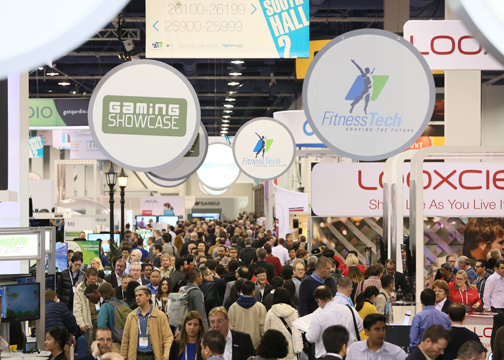CES ’14: Wearables, curved TVs, Internet of everything

The International Consumer Electronics Show has been, for the past 40 years, the technology industry’s greatest showcase of invention and innovation. The 2014 edition, held in Las Vegas from Jan. 7-10, was the largest in show history with a record two million net square feet of exhibit space housing more than 3,200 exhibitors.
“CES is amazing, magical, hands-on, incredible, innovative and inspiring!,” said Gary Shapiro, president and CEO, Consumer Electronics Association (CEA), owners and producers of the yearly event. “This year’s show was an energizing display of where the future is headed, bringing to life cool new products from every industry that touches technology.”
“One-third of the world’s population interacted with CES in some way this week as we experienced the future,” he said. “From curved and flexible Ultra HD TVs and next generation smart phones to drones, robots, sensors, the Internet of Everything, Hi-Res audio, connected cars and 3D printers, it seems like the only thing missing from the 2014 CES was a time-travel machine.”
Shapiro said during the State of the Consumer Electronics Industry address that U.S. consumer technology revenues are projected to see 2.4 percent growth, up to $208 billion — a record high. He also forecasted $6 billion in sales of new categories.
Put in context, this is larger than the entire U.S. machine tool industry. The executive also highlighted recent advances in terms of policy in the US such as the recent approval of electronic device usage on airlines from gate to gate and the industry’s efforts to become more green and increase sustainability.
In addition, the of USTechVets.org website was launched as an online community to connect the one million service members who are transitioning back into civilian life to employment opportunities within the technology industry. Sponsored by the CEA, the Northern Virginia Technology Council and Monster Worldwide Inc., Monster.com, U.S. Tech Vets’ seeks to facilitate veterans’ transition to civilian careers, reduce veteran unemployment and provide America’s veteran workforce access to jobs within the technology industry.
Powered by Monster.com, the website features free tools and resources for employers and for transitioning military personnel, veterans and their family members. Tools for veterans include a military skills translator to match each veteran’s skills, training and collateral duties to civilian jobs; a searchable database of jobs in the technology sector; and educational resources to help veterans develop skills to thrive in a private sector career.
So, what were the major trends at the show this year? Here are a few of them.
Wearable gadgets
This category, more commonly known as wearables, stems mostly from the health and fitness industry and has been a steadily growing trend in 2013. Wearables are small gadgets that can be worn on the body in the form of watches of glasses with integrated sensors that can connect to other devices, phones, WiFi or Bluetooth. These devices can also receive data.
During this year’s show, wearables were at the forefront with gadgets such as the JayBird Reign, which logs your movements and displays related stats, like calories burned and activity duration, then offer up suggestions based on your physical history through its Android and iOS apps. Another such device is SKUPLT, which calculates body composition via electrodes sensing the difference between muscle and fat — provides exercise advice based on individual goals and progress.
Curved TVs and smartphones
Each year, TVs and smartphones get bigger. This year, however, they have changed shape from flat to curved.
Samsung has launched the 105-inch Curved UHD TV, which combines the upgraded curved panel with a greater picture quality engine provides the ultimate immersive experience. On the other hand, the LG G Flex’s curved OLED display is equipped with a curved battery, a 6” HD display; Lifeband Touch fitness activity monitor with Bluetooth connectivity.
Smart cars
Imagine a future where cars no longer need drivers but drive themselves and the roads serve as guides for vehicles. This is what Rupert Stadler, chairman of the board of management of AUDI AG, envisions in auto innovation. The executive announced a partnership with Nvidia and its Tegra K1 as the processor of choice and AT&T to introduce in-car LTE in the U.S as well as its Sport Quattro LaserlightV8 hybrid concept car.
Toyota announced the North American debut of its fuel cell sedan concept with 300 mile driving range, zero-to-sixty in 10 seconds, no emissions and hydrogen tank refueling in 3-5 minutes. Formula E revealed and demoed the first electric racing car with integrated Snapdragon into the cars, adding WiFi and Bluetooth.
Chevrolet also revealed that the Corvette, Impala, Malibu, and Volt would be the first General Motors’ vehicles to come optionally equipped with OnStar 4G LTE, which will act as a built-in WiFi hotspot that will allow passengers to connect their personal devices, such as smartphones, laptops and tablets, to high-speed wireless internet. Each vehicle can accommodate multiple devices at one time.
Internet of Everything (IoE)
People. Process. Data. Things. These used to function separately from each other. Today, the IoE brings them all together by combining machine-to-machine (M2M), person-to-machine (P2M), and person-to-person (P2P) connections.
John Chambers, Cisco Systems chairman and CEO, shared his vision for the IoE by making two predictions, including “2014 will be the transformational and pivotal point for the Internet of Everything,” and “the Internet of Everything will be five to ten times more impactful in the next decade than the entire internet has been to date.”
Chambers demonstrated the potential of embracing IoE by outlining the $19 trillion savings that could be realized in the private and public sector. He cited several examples, including the $13 billion a year alone that is spent on street lighting that could be reduced by 70 percent by using connected technology.
All in all, the IoE is about connecting technology to our everyday lives more intricately and expansively than before.









